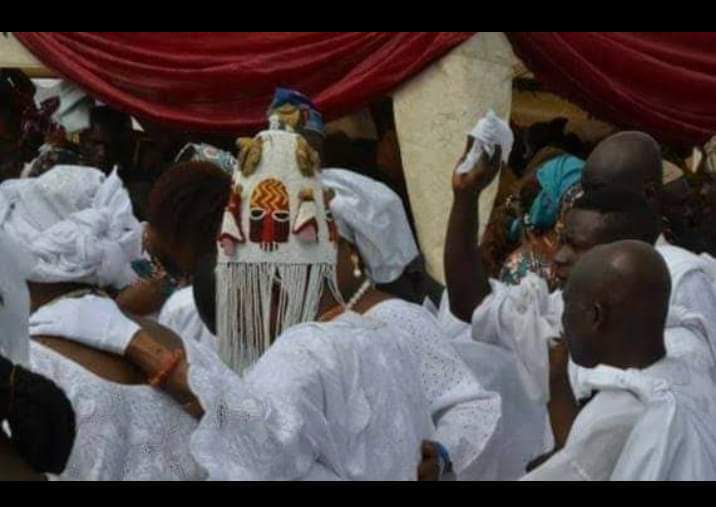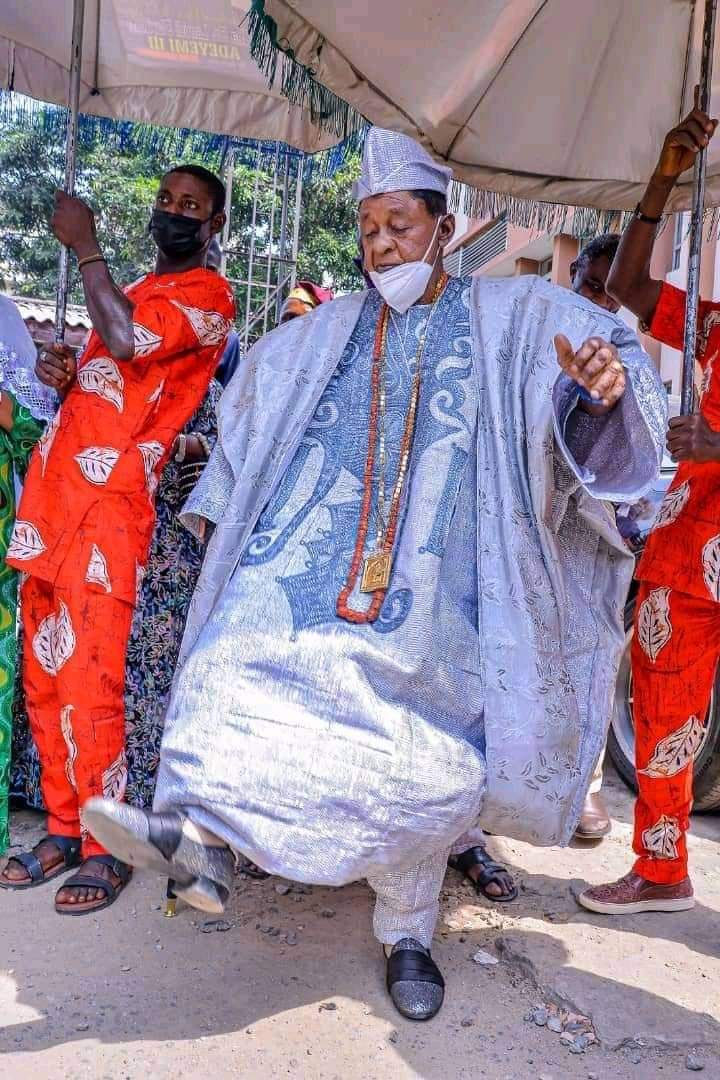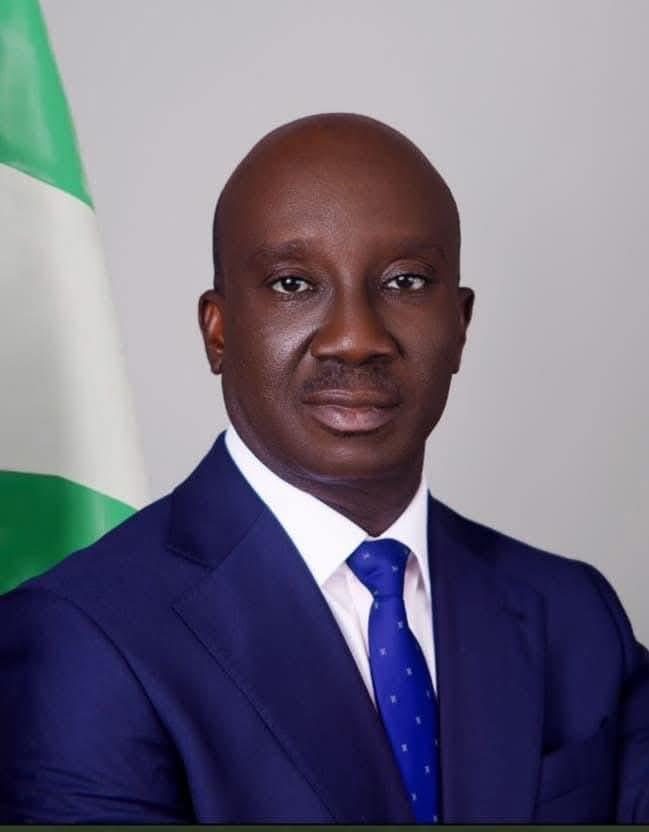The Alaafin was an absolute king; his word was law. He had the power of life and death. He’s iku baba yeye, alase ekeji orisa (the almighty, the ruler and companion of the gods).
In the actual working of the government, however, the Alaafin was an absolute monarch. He governed in conjunction with a council of state known as Oyo Mesi .
Below are the kings who had ruled one of the greatest empires in history.
c.1210– ORANYAN (Oranmiyan)
Oyo-Ile was founded. Oranmiyan was the first king and the founder of the Oyo empire. He was the son of Oduduwa. Oranmiyan was a very brave and warlike king. He was said to have headed his brothers (other Yoruba kings) on an abortive expedition to the east to avenge the death of their father. After quarrelling at a place called Igangan, the brothers dispersed and Oranmiyan went ahead to found the city of Oyo known as Oyo Alaafin.
There are two accounts of his death. Some said he went further East, leaving his son, Ajaka in charge of Oyo, and stopping at a town called Oko, from where he could not proceed and so, died and was buried there.
The second account seems more plausible. It says that Oranmiyan left for Ile-Ife, the land of his father, leaving Ajaka to rule as regent at Oyo. Having stayed in Ile-Ife longer than necessary, the king makers made Ajaka king in Oyo. On returning, Oramiyan heard the kakaaki at the border (the kakaaki is only played for the king). He immediately returned to Ile Ife, where he eventually died and was buried. An obelisk, called ‘Opa Oranmiyan’ was erected at the place where he was buried and is still there to this day.
c.1242– AJAKA
Ajaka was a calm and gentle king. Unlike his father, he was of a peaceful disposition, loved animal husbandry and encouraged it. Being too mild to be warlike, and with the provincial kings encroaching on Oyo, he was deposed and replaced by his fearless and violent brother, Sango. He went to Igboho where he remained in retirement for seven years. After the death of Sango, he returned to the throne.
c.1252– SANGO
He was the step brother of Ajaka. Unlike his brother, he was of a wild and warlike disposition and he had a fiery temper. He had a habit of emitting fire and smoke out of his mouth, by which he greatly increased the dread his subjects had of him.
His mother was the daughter of Elempe, a Nupe king, who formed an alliance with Oranyan by giving him his daughter to wife. Sango defeated many of the other Yoruba kings and expanded the Oyo kingdom. His seven years of reign was marked by his restlessness. He fought many battles and was fond of making charms. He was said to have the knowledge of some preparation by which he could attract lightning. He eventually became tyrannical and was asked to abdicate by the king makers and the senior chiefs.
Rather than abdicating, he hanged himself on a shea butter tree. His brother Ajaka was summoned to return to the throne.
c.1259–AJAKA
Ajaka remains the only Alaafin to rule twice.
c.1277 – AGANJU SOLA
He was Ajaka’s son. He liked taming wild animals and he’s said to have kept a leopard. His reign was long and prosperous. He liked aesthetics and he greatly beautified the palace. Towards the end of his reign, he waged war on a king close-by for refusing to give him his daughter as bride. The king and his allies were defeated and captured by Aganju and the bride, whose name was Iyayun, was forcibly taken. One of the messy scandals of his reign occurred when his son had intercourse with his wife and was summarily executed.
c.1340– KORI
Osogbo and Ede town were founded during his reign. Kori was the son of Aganju, by his captured bride, Iyayun. When he was still a child, his mother ruled as regent. It was during Kori’s time that Timi was sent to Ede to fight the Ijeshas. Timi became too powerful for the king and made himself king at Ede (hence the title, Timi of Ede). Gbonka, was sent to Ede to capture Timi. After Timi was defeated, the king, fearing the rise of a more powerful enemy decided to kill Gbonka. After the failure of the assassination, the king committed suicide.
c.1401– OLUASO
Oluaso, Kori’s son, was a handsome prince. His reign was long and peaceful. He was wise and had many wives and children. He also built 54 palaces for the most influential princes. During his reign, Olofin led the Aworis to present-day Lagos.
c.1490–1542 ONIGBOGI
He was the son of an Ota woman. His mother tried to introduce Ifa (oracle) to the Oyo people. The Oyo people rejected her advice and she left the town. She eventually settled in a town called Ado, where the people accepted her ideas. During Onigbogi’s reign, a war broke out and the king of Nupe invaded Oyo and sacked the capital. The king fled to the land of the Ibariba and died there.
1542– OFINRAN
Saki was founded during his reign. His mother was an Ibariba woman. The Ibaribas started ill-treating the refugees and the king set out for Oyo. Ifa spread to the Oyo people at this time. The refugees camped at a place called Kusu. There the king died before they could move. The next four kings ruled from a town called Igboho.
1550– EGUGUOJO
This Alaafin founded Igboho after the Nupe had occupied Oyo- Ile. He built Igboho, known as Oyo Igboho, and made it the new capital. Besides that, nothing remarkable happened in his reign.
1554–1562 OROMPOTO
Orompoto was the first and only female Alaafin of Oyo. She was the sister of her predecessor, Eguguojo. She assumed the throne in 1554 because there was no male successor from her elder brother at the time.
Legend has it that she cut off her breasts (mastectomy) and put on men’s clothing to look like a man and for the Oyo Mesi to accept her as Alaafin.
In 1557, Alaafin Orompoto (the custodian of the vagina that kills evil plots, the king with the great gift, the king with the flabbergasting gift) strengthened Oyo’s military might. She imported horses from as far as Timbuktu in Mali and had over 1000 horsemen. She did tie leaves on the horses’ tails so that when they went a fighting, the leaves swept the ground after them to cover trails of the horses’ prints.
Orompoto was a skillful commander and a tactical leader. She was brave and won many battles. During her reign, Oyo regained its military prestige and was feared across the south of Niger. She died in the battle of Ilayi in 1562.
1562–1570 AJIBOYEDE
He was a successful and brave king but he was a tyrant. During his reign, the Tapas from Nupe invaded the country again but the king was victorious. The king’s favourite son, Osemolu died. Shortly after, king also died.
1570–1588 ABIPA
Abipa rebuilt Oyo-Ile after the destruction by the Nupe marauders. He decided to carry the seat of government back to Oyo-Ile, even though the nobles were against it. However, he was successful and the king buried charms in strategic places in the city, so that it would not be destroyed again.
1588–1599 OBALOKUN
Salt (Sodium Chloride) was introduced to Oyo-Ile by Portuguese explorers during his reign. His mother was the daughter of the Alake, king of the Egbas. He was also the first Alaafin to have had contact with an European king, most likely King of Portugal, as the Portuguese were the only foreign power present in Yoruba land in the 16th Century.
1599–1658 AJAGBO
His reign was very long. He had a friend at Iwoye called Kokoro-igangan, whom he made the first Aare-Ona-Kankafo (Generalissimo). He was a warlike king and he conquered many people in the West, including the Popos and the Sabes (in Benin Republic). He destroyed Iweme in Popo country after sending four expeditions out at once; under the Basorun, Agbakin, Kankafo, and Asipa.
1658–1659 ODARAWU
His reign was very short. He had a bad temper. He ordered for the destruction of a town called Ojosegi. He was eventually rejected by the noblemen and ended up commiting suicide.
1659–1665 KARAN
He was a tyrant. He was cruel and harsh. He tortured and killed many of his subjects for slight offences. He was so wicked that the proverb ‘as cruel as Kanran’ is being used by the Yoruba to describe anyone perceived of extreme cruelty. The people eventually rebelled against him. He was killed in a coup by the army, backed by the noble men. He fought fearlessly and perished in the inferno that engulfed the palace.
1665–1676 JAYIN
Jayin was Kanran’s son and was made king after his father’s horrible death. He was of a gentler disposition than his father but he was effeminate and his son fell in love with one of his wives. In rage, he killed the boy. He was eventually deposed and tragically committed suicide.
1676–1690 AYIBI
He was the late king’s grandson and the son of the beloved prince whom the king killed. Unfortunately he proved unworthy of the honour and respect accorded to him; he greatly disappointed the hopes of the nation. He was a tyrant and took pleasure in shedding blood. Like his grandfather, he was deposed and he committed suicide.
1690–1692 OSIYAGO
Like his immediate predecessor, he was equally worthless. He was excessive in actions, amassing wealth that he did not live to enjoy. His children fought each other and his foster son, whom he had adopted as the Aremo (heir) was killed by his daughter. The king was eventually poisoned. For 36 years, after Osiyago’s death, the throne was vacant and the country was ruled by the Basoruns (Prime Ministers).
1728–1732 OJIGI
During his reign, Oyo invaded Dahomey. He was elected to a vacant throne. He was warlike, extending his domain to Dahomean territory in present day Benin Republic. He was nevertheless, a good king. He sent out a large expedition to bring all the Yoruba under his control. The expedition is said to have reached the Northern part of the River Niger. Despite the king’s stern disposition, he was too indulgent of his son. The Aremo’s cruelty and excesses eventually caused his father’s rejection. The king was deposed by the noble men and he committed suicide.
1732–1738 GBERU
He was a wicked king, who liked making charms. He fought a bitter conflict with his Basorun who was his friend and both of them were deposed. Just like his predecessor he committed suicide.
1738–1742 AMUNIWAYE
He was a good king initially but soon became weak because of his low morals. He had a affair with the wife of his medicine man. He died of magun while having intercourse with the woman.
1742–1750 ONISILE
He was a great warrior and of great courage. He was brave and warlike, and he was also very artistic. His rashness was the cause of his death. He was struck by lightning and was incapacitated, before being deposed and allowed to die peacefully. Basorun Gaha, the wicked Prime Minister, became the head of the Oyo Mesi during his reign.
1750– LABISI
Shortest-reigned Alaafin till date. He spent only 15 days on the throne. He committed suicide because of pressure from Basorun Gaha. This unfortunate king was elected to the throne but not allowed to be crowned. His Basorun, Gaha, became very powerful, conspired against him and killed all his friends. Labisi eventually committed suicide when he could not rule. Gaa remained powerful, long after him; installing kings as he pleased.
1750– AWONBIOJU
He spent just 130 days on the throne. Installed by Gaha after Labisi, Awonbioju was killed by Gaa when he refused to prostrate for him.
1750–1770 AGBOLUAJE
He was a very handsome prince installed by Gaa. His reign was peaceful and the kingdom was big and prosperous. Basorun Gaha made him fight the king of Popo who was his friend and destroyed his kingdom. In frustration, the king committed suicide before the expedition arrived.
1770–1772 MAJEOGBE
He tried to defend himself against Gaha whose sons were now too powerful. They collected all the tributes and were cruel. The king eventually died in frustration.
1772-1789 ABIODUN
He had a long and peaceful reign. He was handsome, wise and dignified. His reign was so significant that it has since passed into proverbs. The Yoruba believed that Oyo actually started declining after his death. He defeated Basorun Gaha and his children. Abiodun fathered over 660 children and had many descendants which still live till today. His son, Awole, poisond him and succeeded him as king.
1789-1796 AWOLE AROGANGAN
Under him, the kingdom disintegrated as the provinces became tired of Oyo’s tyranny and slavery was rife. He was probably too mild and weak, and had an enemy in Afonja, the Kakanfo who was very powerful. Afonja was stationed at Ilorin with the major part of Oyo’s calvary. Afonja, the Basorun and the Onikoyi eventually led a rebellion against him. As their forces surrounded the city, Aole committed suicide, after cursing Afonja and his co-conspirators. The Oyo empire, and indeed the Yoruba nation, never recovered from this tragedy.
1796-1797 ADEBO
He became king nominally, but never really had powers. The whole land rebelled during his reign and the chiefs clamoured for territories. Afonja declared independence first, and many provinces followed. Afonja won a great victory against the Oyo armies with the help of Alimi, a Fulani and Solagberu, a Yoruba Moslem. He fought several battles in which he subjugated and destroyed many Yoruba cities. Ilorin later became part of the Sokoto Caliphate when the Fulani took over.
1797- MAKUA
His reign was short and tragic. He reigned for only 2 months in 1797. He led an expedition against Iworo and was defeated. He committed suicide in Oyo. The period that followed was the Yoruba civil wars of the 19th century. Between 1800 and 1893, the Yoruba fought a series of wars that decimated huge portions of the country and caused a considerable amount of internal migration. Many large cities were destroyed completely, never to be rebuilt. New cities sprang up, from refugee camps or military bases.
1801-1830 MAJEOTU
After a period when the throne was vacant, Majotu was elected to the throne. He reigned from 1802 to 1830. His reign was full of wars and rebellions. In 1823, Dahomey rebelled, defeated the Oyo army and gained complete independence. Ilorin became a formidable force and started a conquest of Yorubaland, destroying and looting cities in its campaign. The Owu war(1821-1827) also occurred in which the town of Owu was completely destroyed. The Owu later settled in Abeokuta.
1830-1833 AMODO
His reign lasted for three years. He was initially weak, but later proved himself to be a wise and decisive king, despite being unfortunate. He came to the throne at a time when the kingdom was distracted by anarchy and confusion. The Fulanis were having an eye on the capital of Yoruba-land. None of the provincial kings now paid tribute to Oyo or acknowledged the authority of the King. He was virtually King of the capital only.
The Ilorin army plundered Oyo for the first time in his reign, but did not destroy the city. Amodo later united some of the Yoruba chiefs who had turned their backs on the empire. They raised an army and besieged Ilorin but they were betrayed by the Edun of Gbogan, who was the Kakanfo and the army dispersed. Gbongan was later besieged by Ilorin and the Edun defeated. After defeating both the Kankafo and the Onikoyi, and rendering the Alaafin powerless, the Ilorin cavalry easily captured most of the northern Yoruba towns. After that, they turned their conquest southwards, towards the Ijesha tribes, where they faced stiff resistance.
At this time, the remnant of the Oyo and Egba armies began to attack the Ijebus, because of their participation in the Owu war. The whole Yorubaland again became embroiled in civil war.
1833-1835 OLUEWU
During his reign, the Fulani empire had already captured Ilorin after an internal coup and transformed it into a Fulani emirate. Oluewu was then bound to Shita, the Emir of Ilorin. However, he refused to embrace the Islamic religion and sought help from Borgu to defeat the Fulanis. Initially, he recorded some success in battle, but a final putsch to recover the northern part of Yorubaland from the Fulanis led to his death and that of many of Oyo’s leading nobles. Ilorin (under the Fulani) eventually destroyed Oyo.
1838-1858 ATIBA ATOBATELE
He moved the capital from Oyo to Ago Oja (present Oyo). During his reign, the remnant of the Yoruba army moved South and camped in an area that belonged to the Egba of Gbagura clan. The war camp later became the city of Ibadan and it emerged as the new power centre in Yorubaland.
Oba Atiba sought to preserve what remained of Oyo Empire by placing on Ibadan duty of protecting the capital from the Ilorin in the north. Atiba was a great leader but he came at a time of crises. Yoruba had lost Igbomina. Ijesha, Ekiti and Akoko at this time were under threat. Ogbomọṣọ, Ẹdẹ, Iwo, axis were under attack-even Oṣogbo had been defeated, occupied by Fulani. In fact, the entire Yoruba land was under Ilorin-Fulani siege.
However, Ibadan would not allow the onslaught to continue. In 1840, Ibadan soldiers defeated and pushed Fulani warriors back to Ilọrin but could not take the city. Atiba died in 1859. He was the last really great king Oyo had. He tried to restore Oyo’s glory, but the decline was bound to happen as all the tribes were fighting one another. The two current Ruling Houses Agunloye and Alowolodu came out of Atobatele Atiba.
1859-1875 ADELU AGUNLOYE ***one of the Ruling Houses in Oyo Alaafin today.
King Adelu was Atiba’s son. He became king in 1859. The Ijaye war(1860-1862) was fought during his period. Kurunmi, the Are Ona Kankafo, who was the ruler of Ijaiye refused to recognize Adelu as the Alaafin. The war started with Ijaiye declaring war on Oyo in 1860. The Ibadan war machine under Ogunmọla came in support of Ọyọ, routed Kurunmi-Ijaiye/Egba alliance and killed all his sons. Kurunmi committed suicide and Ijaiye was destroyed. The Ijaiye war was one of the several wars Ibadan engaged in to assert supremacy in Yorubaland. In 1864, the Alaafin stopped the Batedo War in the name of Sango between Ijebu and the Egbas.
1876-1905 ALOWOLODU ADEYEMI I ***the second Ruling house in Oyo Alaafin today. In fact the current Ruling House.
After the emergence of Ibadan, the Fulani ceased to be a threat to Yoruba but bitter civil war among the tribes made peace impossible. Between 1860 and 1885 Ibadan engaged in five different wars simultaneously.
In 1877, Ibadan went to war against Ẹgba/Ijẹbu for attacking Ibadan traders, when coming from Port-Novo. The Ijẹṣa/Ekiti seized the moment, in 1878, attacked despotic Ibadan Ajẹlẹs (viceroys) in their territories; Ibadan declared war on Ijẹṣa and Ekiti. The conflict between Ibadan/Ijẹṣa and Ekiti went on for sixteen years, the worst war in Yorubaland.
Ogedengbe-the Seriki of Ijẹṣa army, Fabunmi of Oke-Imesi, and Aduloju of Ado-Ekiti held Ibadan down as Ibadan engaged in other wars with the Ẹgba, Ijẹbu, Ilọrin and the Ifẹ. The Ibadan/Ijesa & Ekiti parapọ war got to its peak at Kiriji, near Ikirun.
The Alaafin was helpless as his people decimated themselves. He therefore invited the British colonial Governor of Lagos to help settled the dispute. Through negotiations undertaken by the Church, which was spearheaded by Samuel Johnson, Charles Phillips, and Lagos Governor, Alfed Moloney in 1886, peace gradually returned to Yorubaland as the warring groups sheathed their swords. The entire Yorubaland later came under the dominion of the British and the Alaafin became a Vassal of the colonial government.
1905-1911 LAWANI AGOJOGA
He was a vassal of the British. He reigned from 1905 to 1911
1911-1944 SIYANBOLA ONIKEPE OLADIGBOLU I
He became king after Lawani. He ruled from 1911 to 1944. He was also a vassal king. The amalgamation of Nigeria happened during his time.
1945-1955 ADENIRAN ADEYEMI II
The Premier of the Western Region, Chief Obafemi Awolowo, deposed and sent him on exile with his Aremo (Crown Prince) for sympathizing with the National Council of Nigerian Citizens (NCNC). He had also come into conflict with Bode Thomas, deputy leader of the Action Group. They both died in exile.
1956-1968 BELLO GBADEGESIN OLADIGBOLU II.
He was the Alaafin when Nigeria gained independence
November 19, 1970- Date LAMIDI OLAYIWOLA ADEYEMI III
Lamidi Adeyemi succeeded Alaafin Gbadegesin Ladigbolu II in 1970, during the governorship of Colonel Robert Adeyinka Adebayo, after the end of the Nigerian Civil War. In 1975, the Head-of-State, General Murtala Ramat Mohammed included Oba Adeyemi in his entourage for the hajj. He was chancellor of Uthman dan Fodiyo University in Sokoto from 1980 to 1992. In 1990 President Ibrahim Babangida appointed him Amir-ul-Hajj in recognition of his commitment to the consolidation of Islam in Nigeria.
Adeyemi is a lover of boxing, as he was a boxer before becoming Alaafin. He remains the only educated Alaafin till date.
Acknowledgement : Ayomide Akinbode
SUMMARY FROM OYO EMPIRE
On my post on the past Alaafins and the past Oonis, we learned the followings:
1. Full name of Sango was Tella Oko Sango Afonja. He was always dressing like a woman to cool down his temper and juju power.
2. Alaafin Orompoto niyun was believed to be a woman. “He” was too “handsome” .
3. Founding period of Osogbo, Ede, Saki, Igboho,Ibadan etc known.
4. Renaming of Eko as Lagos by the Portuguese .
5. That IFE was protected by the awesome IBADAN warriors. But they were fighting Kiriji war instead of Ibadan warriors to join Ijebu to fight the British during the Imagbon War.
6. That Basorun Gaa became powerful and many Alaafins died between 1750 – 1789, that year Alaafin Abiodun liberated himself and Basoun Gaa was executed.
7. That Afonja sold off Ilorin in 1835.
8. That in 1838, Atiba Atobatele founded the current Oyo Atiba Alaafin . Ibadan became powerful and populous being the military base of Alaafin Atiba.
9. 1914 – The Amalgamation !!!!
10. In Ife, OoNI Luwoo Gidigba, believed to be a woman, was the progenitor of Iwo.
11. Sir Adesoji Aderemi became synonymous to OONI stool for so long. Some generations did not know any other Ooni.
12. Giesi 1 was the great, great grandfather of the current OONi Enitan Ogunwusi.
13. That Oni Sijuwade was really an Atobatele. He completely changed the face of OONI stool.
14. That Alaafin did not allow Egba and Ijebu to genocide themselves by invoking the spirit of Sango that pursued them separately with Aara to their different domains !!!
Iree ooo kabiti !!!!
Prince Albert Oladapo Ogunwusi, the current OONI’S brother WROTE :
‘Atobatele’ was originally one of the nick names of Oba Aderemi. He had been king of sorts before being enthroned. He was a learned and successful man with the biggest and most beautiful house in town. Ayinla Tadeniawo Lesimagun, omo Adekunbi Ipetu, abile owo gbindin l’Akui. One who had horses but couldn’t be bothered to ride them. He was succeeded by an equally successful Prince, Okunade Adele Sijuade, Jingbindin bi ate akun, Olubuse eri ogun. A man stalwart like a tray of beads, Olubuse the testimony of war. ‘Jingbindin bi ate akun’ has also been applied to the present Ooni, Kabiyesi Oba Adeyeye Ogunwusi as if all Oonis must be of the same corpulent stature as Oba Sijuwade. Anyway Oba Ogunwusi, a more athletic and younger man has carried that praise well too. The cradle of the Yoruba race has been lucky to have these three great Oonis in succession. Successful and distinguished individuals who carried the title with grace and dignity.
DAVIDSON AYOADE OJENIYI
Below is the picture of Edun Aara ( Sango’s Stone) .

Alaafin is seen in the picture wearing the historic Sese Efun Crown worn by Sango !!!





